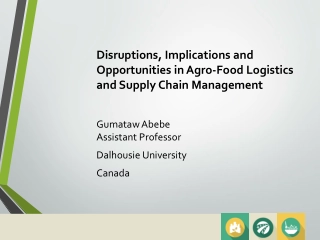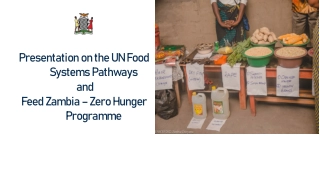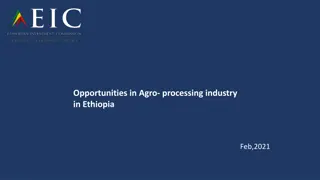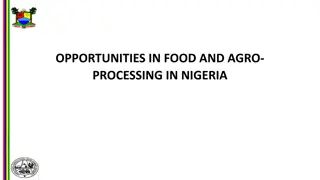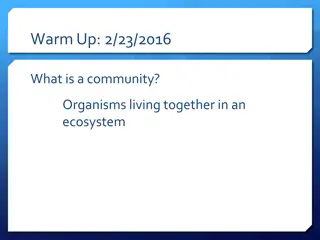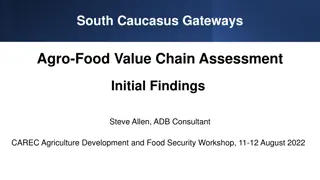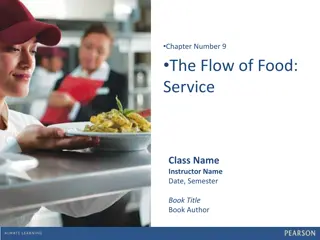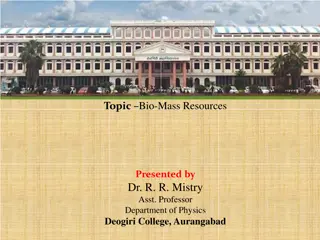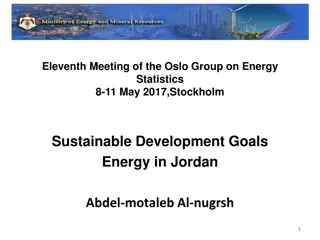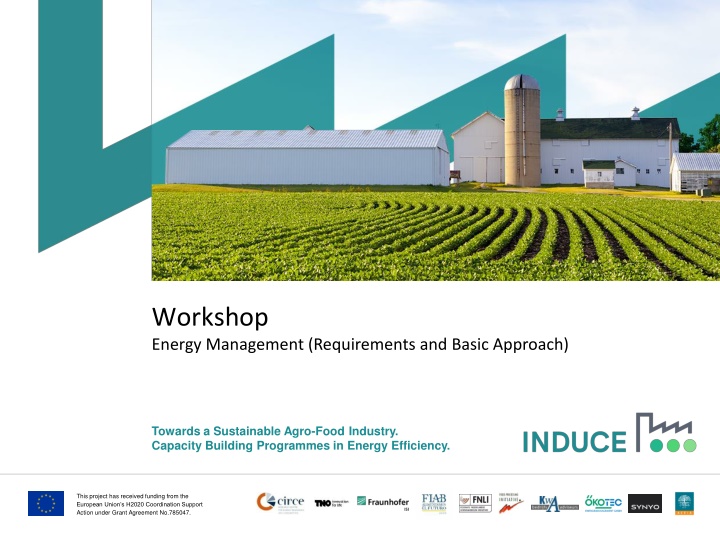
Sustainable Energy Management in Agro-Food Industry
This project focuses on energy management requirements and capacity building programmes for a sustainable agro-food industry, supported by the European Union's H2020 program. It emphasizes energy efficiency, EnMS standards, and the transition to ISO 50001:2018 for energy performance improvements.
Download Presentation

Please find below an Image/Link to download the presentation.
The content on the website is provided AS IS for your information and personal use only. It may not be sold, licensed, or shared on other websites without obtaining consent from the author. If you encounter any issues during the download, it is possible that the publisher has removed the file from their server.
You are allowed to download the files provided on this website for personal or commercial use, subject to the condition that they are used lawfully. All files are the property of their respective owners.
The content on the website is provided AS IS for your information and personal use only. It may not be sold, licensed, or shared on other websites without obtaining consent from the author.
E N D
Presentation Transcript
Workshop Energy Management (Requirements and Basic Approach) Towards a Sustainable Agro-Food Industry. Capacity Building Programmes in Energy Efficiency. This project has received funding from the European Union s H2020 Coordination Support Action under Grant Agreement No.785047.
2.3.1.EN.2_Energy Managers - Energy Management Requirements and Basic Approach Version of: 2.3.1.EN. _Energy Managers - Energy Management Requirements and Basic Approach Description of the changes: This presentation includes only the first two parts of the original version. List of resources used: 3.2.EN_Awareness in Energy Efficiency.
Agenda Introduction and overview Task Focus Top Management GAP Analysis & Results P Plan H A Act Do MANAGEMENT Check V Towards a Sustainable Agro-Food Industry. Capacity Building Programmes in Energy Efficiency. 3 Use the menu "insert" to edit your footer line here
Introduction and Overview Towards a Sustainable Agro-Food Industry. Capacity Building Programmes in Energy Efficiency. 4 Use the menu "insert" to edit your footer line here
50000 family of standards - Overview Energy management systems: guidance for the application, maintenance and improvement of the EnMS ISO 50003:2014 ISO 50004:2014 Requirements for bodies that audit and certify energy management systems. (mandatory for accredited bodies, this indirectly results in requirements for companies as well) Energy Management Systems - Guidance for the application, maintenance and improvement of the EnMS. EN ISO 50001:2018 Energy Management Systems - Requirements with application guidance ISO 50006:2014 ISO 50015:2014 Measurement of energy related performance using energy output bases (EnB) and energy performance indicators (EnPI) - General principles and guidelines. (Guide for users with methodological approaches & practical examples on energy performance indicators, application aid for identifying influencing variables & creation of EnP) Energy Management Systems - Measurement and verification of the energy performance of organisations - General principles and guidance. (Guideline for systematic verification measurements of the implemented measures, preparation of measurement and verification plan). Towards a Sustainable Agro-Food Industry. Capacity Building Programmes in Energy Efficiency. 5 Use the menu "insert" to edit your footer line here
Transitional Regulation Transition period: 3 years 21.08.2018 Publication of the 50001:2018 Expiration date for certificates acoording to old standard 20.08.2021 Afterwards only audits (initial/recertification and monitoring) according to new standard 20.02.2020 Towards a Sustainable Agro-Food Industry. Capacity Building Programmes in Energy Efficiency. 6 Use the menu "insert" to edit your footer line here
Significant changes to 50001:2018 Adoption to the " High-Level-Structure ". Greater responsibility and involvement of Top Management. Stronger integration into strategic management processes, in particular: Context and risk analysis. Securing achievement of objectives. Determination of competence and communication. Resource planning. Introduction of the concept of the normalization of key figures and starting points for more concrete evidence management. Amendments to the Energy Data Collection Plan. Clarification of concepts and updating of definitions. Towards a Sustainable Agro-Food Industry. Capacity Building Programmes in Energy Efficiency. 7 Use the menu "insert" to edit your footer line here
Task Focus Top Management Towards a Sustainable Agro-Food Industry. Capacity Building Programmes in Energy Efficiency. 8 Use the menu "insert" to edit your footer line here
Leadership and Commitment Top management has overall responsibility for meeting the requirements of this document. [ ] In the course of communication within the organisation, top management may emphasise the importance of energy management mediante actividades de participaci n de los empleados como el empoderamiento, la motivaci n, el reconocimiento, la formaci n, las recompensas y la participaci n". UNE EN ISO 50004:2018, A.5 Towards a Sustainable Agro-Food Industry. Capacity Building Programmes in Energy Efficiency. 9 Use the menu "insert" to edit your footer line here
Responsibility Top Management Commitment of Top Management (Section 5.1) Increased responsibility of Top Management o Definition of scope and limits. o Training EnMS Team and support/qualification of relevant actors. o Integration of the EnMS into the business process. o Definition of energy policy, objectives and targets. o Ensuring approval and implementation of action plans. o Ensuring that necessary resources are available. o Communicating Significance of the EnMS. o Ensuring that results are achived EnMS, in particular, improvement of EnMS organisation and Energy-Related Performance. o Ensuring suitable ENPlS with regard to Energy-Related Performance. o Ensuring processes to identify and manage changes. Towards a Sustainable Agro-Food Industry. Capacity Building Programmes in Energy Efficiency. 10 Use the menu "insert" to edit your footer line here
Integration in Strategic Manegement Processes Input Planning Results Strategic Planning Management Identifying measures from Opportunities & Risks Risk & Opportunities Determination Context & stakeholder analysis Quelle: Eigene Darstellung basierend auf DIN ISO 50001:2018, Bild A.2 Plan T ctico o Energy source Energetic evaluation o Evaluation of energy use & consumption o consumption prognosis o efficiency measures o Main consumer (SEU) o key figures o Energy targets o Energy data collection plan Energy Team o Energy input Determination of the SEU incl.: o Relevant variables o Energy-related performance o Relevant staff o Energy consumers Prioritisation of efficiency measures Towards a Sustainable Agro-Food Industry. Capacity Building Programmes in Energy Efficiency. 11 Use the menu "insert" to edit your footer line here
Integration in Strategic Management Processes Inputs for planning Contexte and Stakeholder Analysis. o Determine internal & external topics that have an influence on the EnMS and the energy related performances (environment / context analysis). o Determine interested parties with influence on energy related performances and EnMS. o Determine relevant requirements and expectations of the parties and how to deal with the points identified. Expected Documentation o Context analysis Stakeholder analysis (topics, parties, requirements), possibly as part of the context analysis. o Is a context stakeholder analysis already being carried out Towards a Sustainable Agro-Food Industry. Capacity Building Programmes in Energy Efficiency. 12 Use the menu "insert" to edit your footer line here
Integration in Strategic Management Processes Context Analysis Example Political Factors Economic Factors Social Factors Resources for EnM Education and training Employees Energy efficiency Employee participation regarding energy in the company Responsibility in the region 2 degree target Climate protection at German and European level NAPE Changes in tax policy Corporate policy Business policy Energy price development Commodity prices Tax refund (SpAefV) Energy saving Sales growth / production capacity utilization Subsidies (state, country) o o o o o o o o o o o o o o o o Technical Factors Legal Factors Ecological Factors Compliance with all legal requirements (e.g. StromStG, EnergieStG, EEG) ETS Audit/reporting obligation o CSR o ISO 50001/16247-1 Environmental Constraints Exhaust Emissions Water consumption Energetic building modernisation (e.g. thermal insulation) Requirements of customers with regard to CO2 Green electricity o Energy Technology Development o Sector coupling o Storage technologies o Renewable Energies o E-Mobility o Digitization Infrastructure, software, GLT,... o o o o o o o o o Towards a Sustainable Agro-Food Industry. Capacity Building Programmes in Energy Efficiency. 13 Use the menu "insert" to edit your footer line here
Integration in Strategic Management Processes Stockholder Analysis Example Examples Expectation/Requirement Examples of Interested Parties High return on capital Capital providers/investors o o Corporate management o Adherence to corporate goals o Controlling o Securing energy tax effects o Employees o Innovative & safe workplace o Lawmakers o Compliance with energy legislation o The public o Energy-saving production o Climate Partnership o Compliance with climate targets o Clients o Prices/Availability o Towards a Sustainable Agro-Food Industry. Capacity Building Programmes in Energy Efficiency. 14 Use the menu "insert" to edit your footer line here
Integration in Strategic Manegement Processes Input Planning Results Strategic Planning Management Identifying measures from Opportunities & Risks Risk & Opportunities Determination Context & stakeholder analysis Quelle: Eigene Darstellung basierend auf DIN ISO 50001:2018, Bild A.2 Plan T ctico o Energy source Energetic evaluation o Evaluation of energy use & consumption o consumption prognosis o efficiency measures o Main consumer (SEU) o key figures o Energy targets o Energy data collection plan Energy Team o Energy input Determination of the SEU incl.: o Relevant variables o Energy-related performance o Relevant staff o Energy consumers Prioritisation of efficiency measures Towards a Sustainable Agro-Food Industry. Capacity Building Programmes in Energy Efficiency. 15 Use the menu "insert" to edit your footer line here
Integration in Strategic Management Processes Planning Process Risk and Opportunity Analysis o Determination of opportunities and risks for Energy Related Performances and EnMS o Define measures for dealing with opportunities and risks o Evaluate the effectiveness of the measures Documentaci n esperada o Opportunities and risk analysis (if necessary within the context of context analysis) o Measures for dealing with opportunities and risks (if necessary in action plans, corrective and preventive action plans or EnMS action plans) Is a risk an lisis already being carried out Towards a Sustainable Agro-Food Industry. Capacity Building Programmes in Energy Efficiency. 16 Use the menu "insert" to edit your footer line here
Integration in Strategic Management Processes Result: Identification and definition of objectives Target System Results Management Identification of measures from opportunities & risks System-Target o Evaluation of energy use & consumption Energy Team o consumption prognosis o efficiency measures Energy Target o Main consumer (SEU) o key figures o Energy targets o Energy data collection plan Are there already Sistem Targets Towards a Sustainable Agro-Food Industry. Capacity Building Programmes in Energy Efficiency. 17 Use the menu "insert" to edit your footer line here
Responsibility Top Management Changed Organizational Structure o Focus on energy team instead of individual management managers. o Identification of competence requirements and communication. How do your role looks like Towards a Sustainable Agro-Food Industry. Capacity Building Programmes in Energy Efficiency. 18 Use the menu "insert" to edit your footer line here
Identification of competence and communication New standard requirements: o Determination of the required competence for persons (also external!) with influence on ebL or EnMS o Introduction to Acquiring the Required Competence and Testing Effectiveness o Determination of internal and external communication (what, when, how, who with whom) o Ensuring reliable and EnMS-compliant content Expected Documentation: o e.g. competence matrix, competence requirement in the job description, etc. o Process for regulating communication incl. Communication matrix o Process for submitting suggestions for improvement, including a decision as to whether suggestions for improvement should be retained Are competence requirement from EnMS already considered Towards a Sustainable Agro-Food Industry. Capacity Building Programmes in Energy Efficiency. 19 Use the menu "insert" to edit your footer line here
TOWARDS A SUSTAINABLE AGRO-FOOD INDUSTRY. CAPACITY BUILDING PROGRAMMES IN ENERGY EFFICIENCY.

